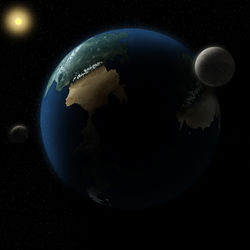
|
| New Tython (Harakoa)
|
|
Outer Rim Territories
|
|
Esstran sector
|
|
DLSCX-2298 (Yhi System)
|
|
1: Yhi
|
|
2: Iah, Kalfu
|
|
1.1 AU
|
|
389 Standard Days
|
|
Terrestrial
|
|
9,645 km
|
|
Type I
|
|
-20 to 48˚C
|
|
1.23 x Standard
|
|
Variable
|
|
|
|
Harakoans
|
|
Humans, Mon Calamari, Various Species
|
|
Basic, Harakose
|
- ~100,000 Human Colonists
- ~50,000 Mon Calamari Colonists
- ~300,000,000 Natives
|
|
Menat Ombo, Dac Compound
|
|
None
|
|
None
|
|
Odan-Urr
|
New Tython, known as Harakoa to the native people, is the home planet of House Odan-Urr.
Geography
There are four continents on New Tython; ranging from the gigantic continent of Owyhyee in the North West Hemisphere, which has a wide range of different climates (including deserts and grassy plains), to the smallest continent of Sanulu covered in mountain ranges peppered by dozens of semi-active volcanoes, resulting in the region being christened "The Inferno" by the various native populations.
Apart from Owyhyee and Sanulu, there are the two other continents of Kamuekiko and Milil’ea, as well as various islands spread across the oceans of the planet. One such grouping of islands approximately 250 kilometers off the west coast of Sanulu has never been colonized by native or immigrant populations, owing primarily to the fact that they are composed almost entirely of volcanic rock and glass and have no native wildlife upon them.
Owyhyee
(pronounced: "O-wih-hee-ay")
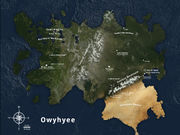 Owyhyee
Owyhyee
Owyhyee is situated in the North West Hemisphere and is 1,620 miles from east coast to west coast, and 1,450 miles from north coast to south coast. It is sparsely populated, encouraging a nomadic lifestyle, though it also houses the planetary seat of government, Menat Ombo. The vast grasslands of Owyhyee is home to countless species of both flora and fauna. Vast herds of beasts which the natives hunt for food and clothing support approximately 500,000 indigenous people divided into hundreds of small communities. Several major rivers flow across this area, fueled by countless snow melt tributaries nestled deep in the continent's central mountain range. The grasslands in the east of the continent are split from the Honunom desert by a small mountain chain that reaches an average height of 2,000 meters. The vast height of the mountains discourages the natives from passing over them, however notable villages in the primary passes to the Honunom desert command trade through the region.
The Honunom desert reaches a max temperature of 48 degrees Celsius during the day in summer, but is prone to plunging well below freezing at night. Life is sparse in the desert, as is water, but there are several oases spread across the desert where they tap into the deep water table.
On the other side of the desert, if one manages to travel through it, is another expanse of grassland punctuated by forests which have been partially cleared and plundered to make room for the capital of Menat Ombo and the dozens of colonial and sedentary farms clustered around the small city. The capital is situated on the banks of the vast, turbulent River Sabina, which is prone to seasonal flooding, and eventually flows into the Bythic Ocean.
Kamuekiko
(pronounced: "Ka-mue-kee-ko")
 Kamuekiko
Kamuekiko
Situated directly South of Owyhyee, Kamuekiko is attached to the Northern continent by a narrow isthmus of desertified land. The continent itself is covered in tropical rainforest which eventually tapers into a mountain range. Despite the relative geological calmness, there are occasional earthquakes in the area. To the southwest the land is dominated by rocky plains, where limestone and chalk outcroppings are common.
The rainforests are largely unexplored by the colonists or Jedi due to the dense undergrowth which prevents travel of large groups. However, drawing from the superstition of populations bordering the area, one can assume there are tribes living within. The coasts have many natural (including some deep water) harbors. The rocky plains below the rainforest have a weakened presence of natives due to the established colony of Mon Calamarians. Unable to compete with the settlers, the natives have migrated further north towards the edges of the rainforests.
The isthmus between Owyhyee and Kamuekiko is part of the Honunom desert, which often discourages migration between the two continents.
Kamuekiko is a narrow continent, but quite long, stretching down to the 48th degree of longitude. This is the cause of the extremely cold weather in winter. The continent measures 2,764 miles from the isthmus between Owyhyee and Kamuekiko to the southern tip. From the east to west coasts, it measures only 800 miles at the widest point. Off the west coast of Kamuekiko lays an archipelago, consisting of hundreds of tiny islands.
Sanulu
(pronounced: “San-u-lu")
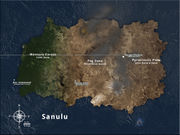 Sanulu
Sanulu
Situated in the North Eastern Hemisphere of New Tython, Sanulu is the smallest of the four continents of New Tython, consisting of an extreme climate due to the constantly erupting volcano-networks permeating its rugged geography. The constant flow of lava increases the size of the continental shelf by up to five miles per year (depending on yearly flow-size). Due to the ash thrown up into the atmosphere, the air above the interior of the continent is high in nitrogen and carbon dioxide making it unsuitable for sentient habitation, though there are minor settlements on the more temperate and geologically calmer coastlines.
Sanulu is small in size compared to the other three continents, measuring only 800 miles from its east to west coast and 369 miles from its north to south coast. However, it is growing each year. It is calculated that if it continues to grow in size at its current pace, the continent will rival Kamuekiko in size in approximately 3,000 years time.
Milil’ea
(pronounced: "Me-lil-ee-ah")
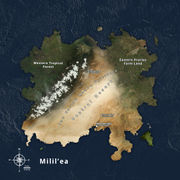 Milil'ea
Milil'ea
Milil'ea is the second largest continent of New Tython and it has the biggest number of different habitats within its interior. These range from perpetual tundra in the far south of the continent, to desert within the centre of the continent. In the north of Milil'ea is a vast grassland area, that is dotted with signs of glaciation in the past, fallen stones that had been dragged hundreds of miles from their source.
To the west is a large rainforest, where the native species prosper, the area unexploited by the settlers that descended upon New Tython. The rainforest abruptly tapers into a large mountain range that are the result of shifting tectonic plates hundreds of millions of years ago, however earthquakes do habitually occur, causing landslides and flooding when the rains come.
To the south of the mountain range lies the vast tundra, populated mainly by migrating tribes that follow the vast herds of the native arctic species.
The east side of Milil'ea is heavily populated by farming communities, taking advantage of the large amount of rivers in the east of Milil'ea. Dotted in between the farms are a series of woodlands and lakes that attract Mon Calamarian settlers.
The desert in the centre of Milil'ea is slowly expanding to the east as desertification occurs due to the over-farming of the land by the settlers, a problem that the Acolytes of Odan-Urr hope to stem.
Milil'ea is 1,670 miles from north to south at its widest point, while it measures 1,540 miles from east to west, a truly vast continent.
Planetary History
New Tython coalesced out of the protoplanetary disk around the star Yhi approximately 5.5 billion standard years ago. As the planet cooled, outgassing and volcanic activity produced an atmosphere around the relatively small planet, and collisions with ice comets created its seas and oceans. At this point, two principal landmasses formed on opposite sides of the planet, and tectonic activity began to slowly twist and mold these two early continents towards the contours familiar to us.
Evolution of Life
Meanwhile, not one billion years after the formation of the planet, the first lifeforms are believed to have arisen inside the oceans of New Tython. At first no more than replicating strings of genetic material, they steadily but surely evolved into bacteria, then eukaryotes with endosymbionts. It is conjectured that, at this point, a small ice comet containing microorganisms from an unknown planet dropped into New Tython's waters and released its living cargo into the oceans, sparking a vigorous competition with the native microorganisms. This would explain the early evolution of multicellular organisms on the planet and the abnormally profuse diversification that took place during this period.
Fossil evidence shows that, by around two billion years BBY, complex multicellular organisms were already developing, very precociously by galactic standards. During the next several million years, a series of meteor impacts and severe tectonic movements split Harakoa's two supercontinents into thousands of smaller landmasses, at the same time isolating its seas and oceans to varying extents. It is believed that, after this tectonic upheaval subsided around 1.2 billion years BBY, there was an upsurge of new land-living animals. This meant that many aquatic species evolved separately to breathe air and "walk" on land, thus explaining the enormous variety of land animals seen today on Harakoa.
With regards to the land flora, it had already reached a high level of development and diversity by 1.2 billion years BBY, thus allowing the newly emerged land animals to prosper amid vegetation that had not yet evolved defenses against herbivores. As the many distinct ecosystems grew and established their roots, a slow movement of the planet's tectonic plates eventually brought the many smaller landmasses together to form the modern continents. This had a major impact on the evolution of land organisms, because many animals, plants, fungi and microorganisms that had evolved separately on discrete landmasses now met and interacted for the first time.
Over the course of one billion years, this forced amalgamation of distinct ecosystems caused numerous cycles of upsurge and decline of certain animal phyla. For example, during the ice age around six hundred million years BBY, the giant furred ursidae of the northern tundras came to dominate almost the entire planet; while during the planet-wide volcanic ash storms of around four hundred million years BBY the chitinous arthropods of the equatorial deserts ruled Harakoa. During these periods, the myriad other lifeforms did not die out, but simply subsided, to reemerge once the hegemony of the time had declined.
Evolution of Harakonids
This rhythm began to wane around fifty million years ago, when a (taxonomic) family of primates, called the Harakonids, emerged from the western Milil'ean jungles. These adaptable omnivores had a distinct advantage over prey and predator, because they had developed a form of communication much more complex and efficient than any other Harakoan animal. This communication was possible because of the Harakonids' hollow cranial crest, which served as an amplifying chamber for howls and hoots let out through the nose. It also granted them a much wider range of pitch and tone than other wildlife. While still considered animals at this stage in their evolution, the Harakonids used their communication skills to assemble themselves into organized and well structured packs. Their group coordination gave them a distinct advantage when hunting prey, fleeing or fighting predators and searching for resource-rich territories.
The early Harakonids' communication skills allowed them to adapt to new situations and environments in a relatively short time, because survival strategies discovered by one individual would be divulged and taught to all other members of the pack, and possibly to other packs as well (a sort of mutually beneficial social evolution). This compares to the much slower process of evolution by natural selection of genetic traits, which the other lifeforms of Harakoa were stuck to (note that the Harakonids were still undergoing this process, in addition to their social evolution). By virtue of this adaptability, the Harakonids spread to populate all the diverse environments of Milil'ea. Fossil evidence of Harakonids in the far northern Milil'ean grasslands have been dated to around forty million years BBY, followed closely by fossils in the southernmost Milil'ean tundra, demonstrating the Harakonids' swift expansion. They even reached the coasts of Sanulu, possibly during a short glacial period that extended the polar ice caps around twenty million years BBY.
The next major evolutionary leap occurred between 35 and 20 million years BBY. Fossil evidence shows that, during this period, the cranial crest and nasal cavity of Harakonids became much more intricate, able to produce a range of elaborate sounds approaching speech in complexity. Furthermore, intact skeletons of several animal species were found within Harakonid graveyards from this period. All of this is taken as evidence that the Harakonids were beginning to develop Sonance (see below) during this period. By using Sonance on herbivore herds and predators, the Harakonids laid down the rudimentary foundations of nomad pastoralism and hunter-gatherer tribal culture, long before the domestication of fire or the invention of stone tools.
The Harakonids did not achieve full-time bipedalism until around 700,000 years ago. In less than half a million years this was followed by a boom in technological and social advancement across the whole of Milil'ea and Sanulu. Because of their precocious communication skills, the Harakonids were able to race through the paleolithic and neolithic ages, and by around 1000 BBY metallurgy was prevalent in all Harakonid populations. Unlike many other prehistoric peoples, however, the Harakonids adhered to their nomadic lifestyle throughout their whole history.
Evidence of the first written records in around 800 BBY heralded a giant leap in Harakonid culture, and it is at this point that they diversified into the many tribes existing today. This marks the point where Harakonid prehistory ends and Harakoan history begins.
Indigenous Peoples (Harakoans)
- Main article: [[Harakoan|Harakoan]]
Harakoan Tribes
For examples of Harakoan tribes see:
Biology and Appearance
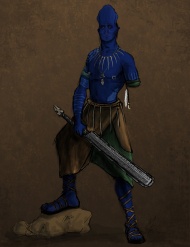 A Harakoan warrior
A Harakoan warriorHarakoans are cerulean-skinned, purple-blooded humanoid mammals. They have a tall cranial crest, long vertical nostrils with no protruding nose and four-digit hands and feet; apart from these features, they are anatomically very similar to Humans. Their skin color usually changes between ethnic groups, from dark, intense cerulean in the equatorial tribes to pale, faded cerulean in the boreal tribes. Hair grows over the back of their crest and skull, and males also grow beards. Desert and boreal Harakoans tend to have darker hair, while jungle and steppe Harakoans usually have blonde or bluish-grey hair. The same applies to the eyes, with dark purple or brown irises for desert and boreal Harakoans, and lighter blue and grey for jungle and steppe Harakoans (there are no known green-eyed Harakoans).
The most distinctive feature of Harakoans is their tall cranial crest, which can extend up to 40 cm (16 inches) above their brow. This crest is an extension of the skull bone, and inside it is a complex arrangement of hollow chambers which connect to the nostrils. These amplifying chambers allow the Harakoans to produce very loud calls from their nose, which sound like wind or brass musical instruments. The timbre of these calls differs between the ethnic groups of New Tython; the call of equatorial Harakoans typically sounds like a crumhorn, while that of boreal Harakoans sounds more like a bassoon. The shape of the crest also varies. Desert-dwelling Harakoans have broad, densely vascularized crests, which aid them in the dispersal of body heat; boreal tribes have taller, more robust crests which they sometimes use in fights; jungle tribes have shorter rounded crests which allow them to travel through the dense vegetation unhindered.
Colonists (Tythonians)
- Main article: [[Tythonians|Tythonians]]
Tythonian Species
For examples of Tythonian species see:
Colonial Population
Tythonians, as they call themselves, are a diverse group of individuals having arrived on New Tython since the establishment of the original, colonial community. They are composed almost entirely of Humans and Mon Calamari (owing partly to the close proximity to the ocean planet) though in recent years an influx of refugee-colonists has bolstered the colonial population, and diversified it to include species whose worlds were razed by the Yuuzhan Vong, particularly Ithorians, Rodians, and Duros. Tythonians make up the bulk of New Tython's population, with the Harakoans occupying the second-larged population.
Notes
Fortchcoming….